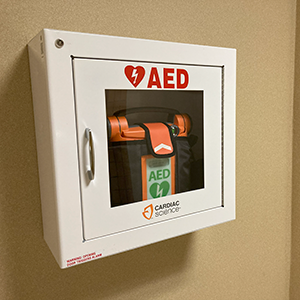Automatic External Defibrillator Program
The Automatic External Defibrillator (AED) Program is an integral part of Purdue University Northwest’s commitment to the safety and health of staff, faculty, students and visitors.

Automatic External Defibrillator
The purpose of this program is to provide public access to university-maintained AEDs for use in the event of a sudden cardiac emergency. Abnormal heart rhythm is the common cause of most sudden cardiac arrests. When the heart rhythm becomes chaotic, often without warning, the heart will stop abruptly.
The American Heart Association (AHA) states that survival from sudden cardiac arrest depends directly on the speed at which a defibrillation shock is delivered in an attempt to restore normal heart function.
A complete list of the locations of AEDs on Purdue University Northwest’s (PNW) Campuses is provided in this guide.
At PNW, we use the Cardiac Science Powerheart G3/G5 AEDs. These AEDs are made for novice first responders and feature voice and text screen “coaching” to make your rescue as simple as possible. The machine will tell you when to provide compressions and breaths. There are no buttons to push; the AED will do it all for you. If it detects a positive change in the patient’s heartbeat, it will not provide shocks.
Before Giving CPR
Check the scene and the person.
Make sure the scene is safe, then tap the person on the shoulder and shout, “Are you okay?” to ensure that the person needs help.
Call 911 for assistance.
If it’s evident that the person needs help, call (or ask a bystander to call) 911. Send someone to get an AED.
If an AED is unavailable or there is no bystander to access it, stay with the victim, call 911 and begin administering assistance.
Open the airway.
With the person lying on their back, tilt the head back slightly to lift the chin.
Check for breathing.
Listen carefully for no more than 10 seconds for sounds of breathing. Occasional gasping sounds do not equate to breathing. If there is no breathing, begin CPR.
Red Cross CPR Steps
Push hard, push fast.
Place your hands, one on top of the other, in the middle of the chest. Use your body weight to help you administer compressions that are at least 2 inches deep and delivered at a rate of at least 100 compressions per minute.
Deliver rescue breaths.
With the person’s head tilted back slightly and the chin lifted, pinch the nose shut and place your mouth over the person’s mouth to make a complete seal. Blow into the person’s mouth to make the chest rise. Deliver two rescue breaths, then continue compressions.
Continue CPR steps.
Keep performing cycles of chest compressions and breathing until the person exhibits signs of life, such as breathing, an AED becomes available, or EMS or a trained medical responder arrives on scene.
Locations of AEDs on Purdue Northwest Campuses
Westville Campus
AEDs are available inside each building and in all Westville police patrol vehicles.
- First floor – Near the fitness center welcome desk, by the fitness/weights area
- Second floor – East wall by cardio equipment
- Inside the north door, next to the emergency phone
- Ground Floor – west side of building by stairwell, adjacent to Student Services
- Inside northeast door
Hammond Campus AED Locations
AEDs are available inside each building and in all Hammond police patrol vehicles.
- Main entrance, near south elevator
- Fitness weight room – Front desk
- North entrance front desk
- Northwest hallway, opposite of restrooms
- West entrance (south) doors
- Second floor – directly across from the elevators
- Third floor – northwest hallway, adjacent to the Office of Engagement
- First floor – Southeast side of the building, adjacent to restrooms
- Second floor – northwest side of the building
- Second floor – northeast side of building (in the nursing department)
- Third floor – southeast side of building, adjacent to restrooms
- East entrance lounge area – near room 119
- West entrance lobby
- First floor – north elevator
- Main entrance (south) service desk
- Main entrance (west door)
- Main entrance (north)
- Main floor – West side hall